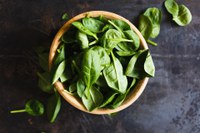Prairie Fare: Harvest Fresh Herbs to Add Flavor to Your Recipes
(Click an image below to view a high-resolution image that can be downloaded)
By Julie Garden-Robinson, Food and Nutrition Specialist
NDSU Extension
I pulled some weeds from my raised gardens the other day, and I must have accidentally pulled some basil leaves in my quest.
The unique scent of basil followed me into my house. My daughter commented about the aroma of basil when I walked by.
She likes to gather fresh mint and make hot tea. I like to add mint and basil to ice water to make flavor-infused water.
You can buy fresh herbs in many grocery stores and at farmers markets. You may have a friend with prolific culinary herbs who might share some with you.
Using freshly harvested herbs in cooking tops the taste of dried herbs in just about every instance.
Be a little adventuresome with flavorful herbs. Try preparing a pizza or pasta dish with dried oregano and basil vs. fresh, and you’ll see which imparts the most pronounced flavor and aroma.
Make a simple salad of skewered fresh mozzarella, cherry tomatoes, basil leaves and a drizzle of balsamic vinegar. Your friends will label you a gourmet chef.
Herbs add flavor and negligible, if any, calories and other nutritional value. However, using herbs in cooking can offer some potential health benefits.
Many people find they can cut down on the amount of salt and fat in their recipes when they add herbs. Using less sodium and less fat are good moves toward heart-healthy cooking.
Before using fresh herbs, be sure to rinse them well under running water. Next, use a pair of scissors to snip the herbs or a sharp knife to chop them into tiny pieces.
For optimal flavor, expose as much surface area as possible. For dried herbs, use a mortar and pestle (available in most kitchen supply stores or catalogs) to grind the herbs into a powder.
Here’s a rule to remember: Don’t overdo herbs in a dish. Use herbs for variety and accent only. Usually one strongly flavored herb alone or paired with one or two more mildly flavored herbs is a better bet. In recipes calling for dried herbs, substitute a larger amount of fresh herbs.
No two herbs are exactly alike, so generalizing is difficult; however, the usual comparison is 2 teaspoons of fresh herbs equals three-fourths teaspoon of dried herbs equals one-fourth teaspoon of powdered herbs.
Herbs also can be categorized by strength. Strongly flavored herbs include bay, rosemary and sage. About 1 teaspoon per six servings will suffice.
Moderately flavored herbs include basil, dill, mint, marjoram and oregano. Use about 2 teaspoons for every six servings.
Mildly flavored herbs include chives and parsley. These combine well with other herbs and can be used generously.
With the amount of fresh herbs I have, drying or freezing herbs probably is among my future summer endeavors. You can air-dry, oven or dehydrator dry, microwave dry or freeze.
To air-dry, tie the leaves together with string and hang upside down in a well-ventilated, dark place such as a cool basement.
In general, pick plants at their peak, rinse and pat dry. To dehydrator dry, follow the manufacturer’s instructions.
Microwave drying usually involves placing bunches of rinsed leaves between microwave-safe paper towels. Microwave on high for 30 seconds at a time, then cool. The leaves should crumble easily when dry.
Store the dried herbs in labeled, air-tight containers such as glass jars. For best flavor, use dried herbs within one year.
To freeze, place rinsed herbs in freezer bags and press out air. Or place chopped herbs in ice cube trays, cover with water and freeze. Pop the ice cubes into labeled freezer bags. Add a cube or two to soups or stews to add flavor. Visit https://www.ag.ndsu.edu/food and search for “garden to table herbs” for more information.
Here’s a tasty way to enjoy fresh herbs. Experiment with your favorite fresh or dried herbs. Add a little at a time. This goes well with warmed slices of French bread or crisp crackers.
Herbed Cream Cheese
1 lb. low-fat cream cheese
1/2 lb. butter
1 clove garlic, minced
1/4 tsp. white pepper
1/2 tsp. chopped fresh basil leaves
1/4 tsp. chopped fresh marjoram leaves (optional)
1/8 tsp. chopped fresh thyme leaves (optional)
Place cream cheese and butter in food processor or mixer. Add minced garlic and herbs and blend. Store the spread in the refrigerator and allow to soften before serving. Serve with bread or crackers.
Makes 24 servings (about 2 tablespoons each). Each serving has 110 calories, 12 grams (g) fat, 2 g protein, 0 g carbohydrate, 0 g fiber and 140 milligrams sodium.
(Julie Garden-Robinson, Ph.D., R.D., L.R.D., is a North Dakota State University Extension food and nutrition specialist and professor in the Department of Health, Nutrition and Exercise Sciences. Follow her on Twitter @jgardenrobinson)
NDSU Agriculture Communication - July 29, 2021
Source: Julie Garden-Robinson, 701-231-7187, julie.garden-robinson@ndsu.edu
Editor: Ellen Crawford, 701-231-5391, ellen.crawford@ndsu.edu




